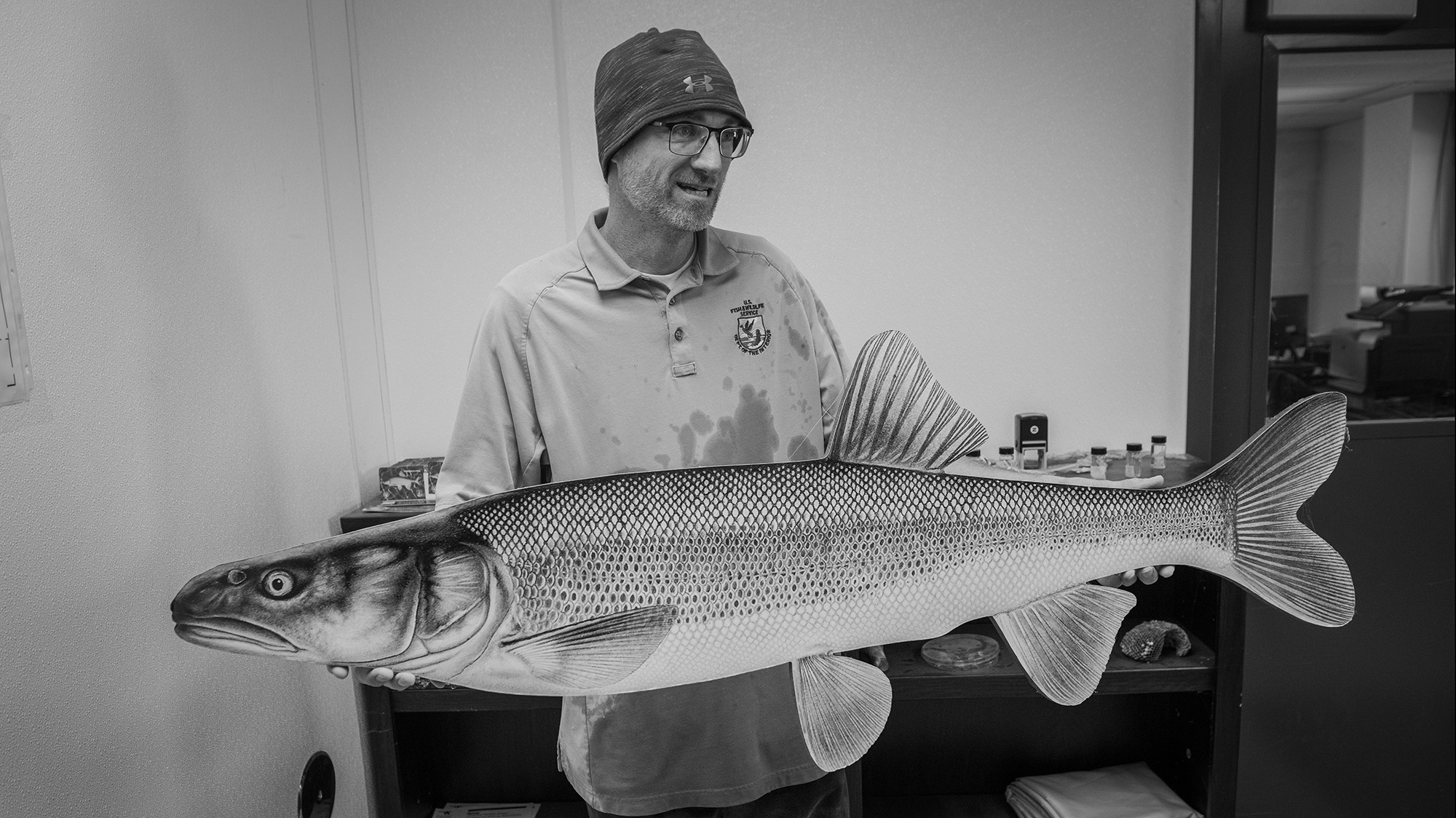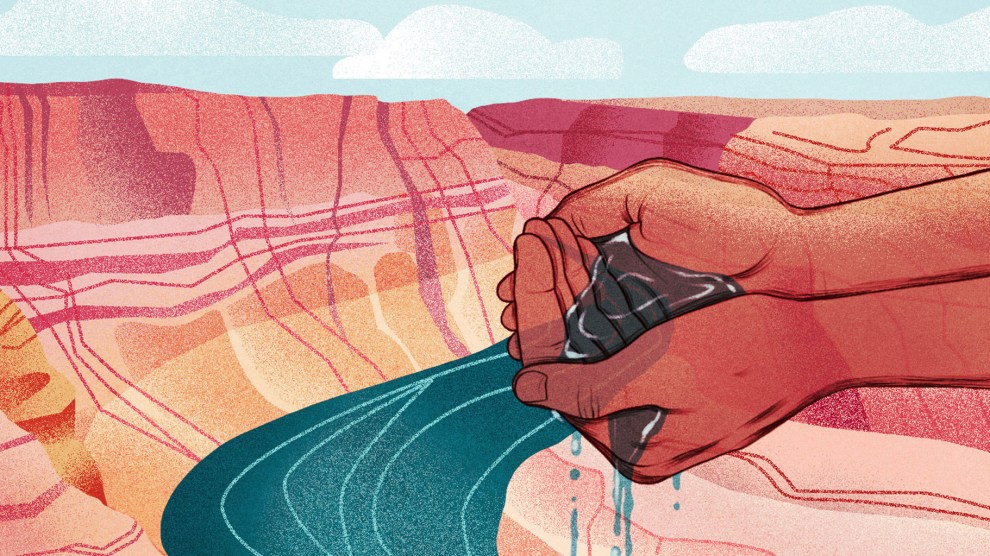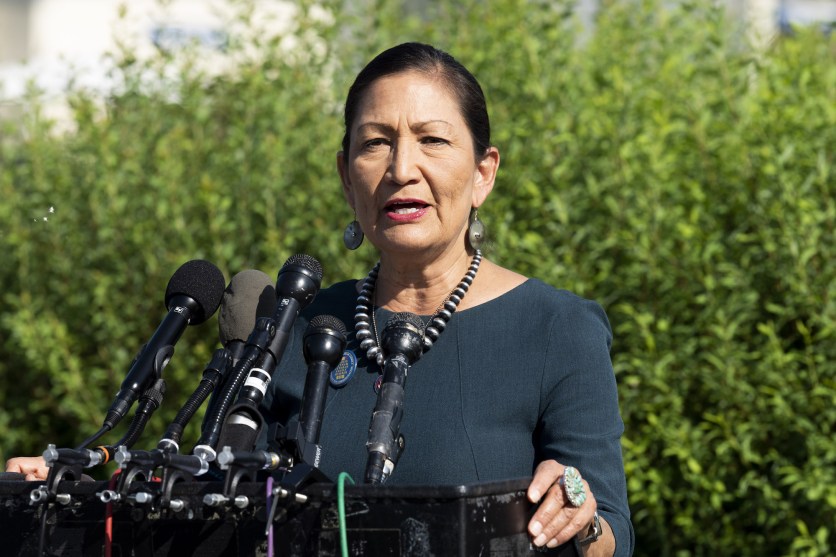“You’re looking at the most endangered fish in North America,” Zane Olsen, the manager of the Ouray National Fish Hatchery tells me as he points to a deep open-topped water tank. Inside are dozens of juvenile bonytail, the rarest of four endangered native Colorado River fish species and one Olsen and his colleagues are trying to bring back from the brink of extinction.
When I arrived at the hatchery one clear morning in May, Olsen was already soggy. Fish eggs mottled his pink polo shirt, and the tall, rangy fellow didn’t seem to have a moment to stand still. The hatchery essentially functions like a fertility clinic for fish, and this was the one day a year that it spawns the razorback sucker, another endangered fish that makes up the bulk of the hatchery work. (The Colorado pikeminnow and the humpback chub, the other two endangered Colorado River basin fish, are raised elsewhere. ) Three days earlier, hatchery workers had injected the razorback with hormones to ripen their eggs, and now they had a short window for capturing them. I’d come to help with the spawning and to learn more about how the endangered fish are faring after more than two decades of drought in the West.
Found nowhere else in the world, the native razorback has occupied the waterways of the Colorado River basin for at least 3 million years, one reason why Olsen says they’re known as the “dinosaurs” of the Colorado. Known as “detritivores,” the bottom-feeding fish were once an important part of the river’s food chain because they nosh on dead plant and animal matter that might otherwise build up and cause disease while returning essential nutrients to the ecosystem. The fish have adapted to the harsh monsoon-to-drought cycles of the desert rivers that flood with melted mountain snowpack in the spring and are parched in the late summer. Razorback suckers can grow up to three feet long, 80 pounds, and live for 50 or 60 years. But such geriatric monster fish are rare in the wild today.
The native fish have not fared so well over the past century since humans began trying to make the western desert bloom by damming the Colorado and its tributaries, a watershed that was once one of the most biologically diverse in North America. “They’re a bellwether for the health of the entire river ecosystem, from Wyoming to the Gulf of California,” says Taylor McKinnon, senior public lands advocate at the nonprofit Center for Biological Diversity.
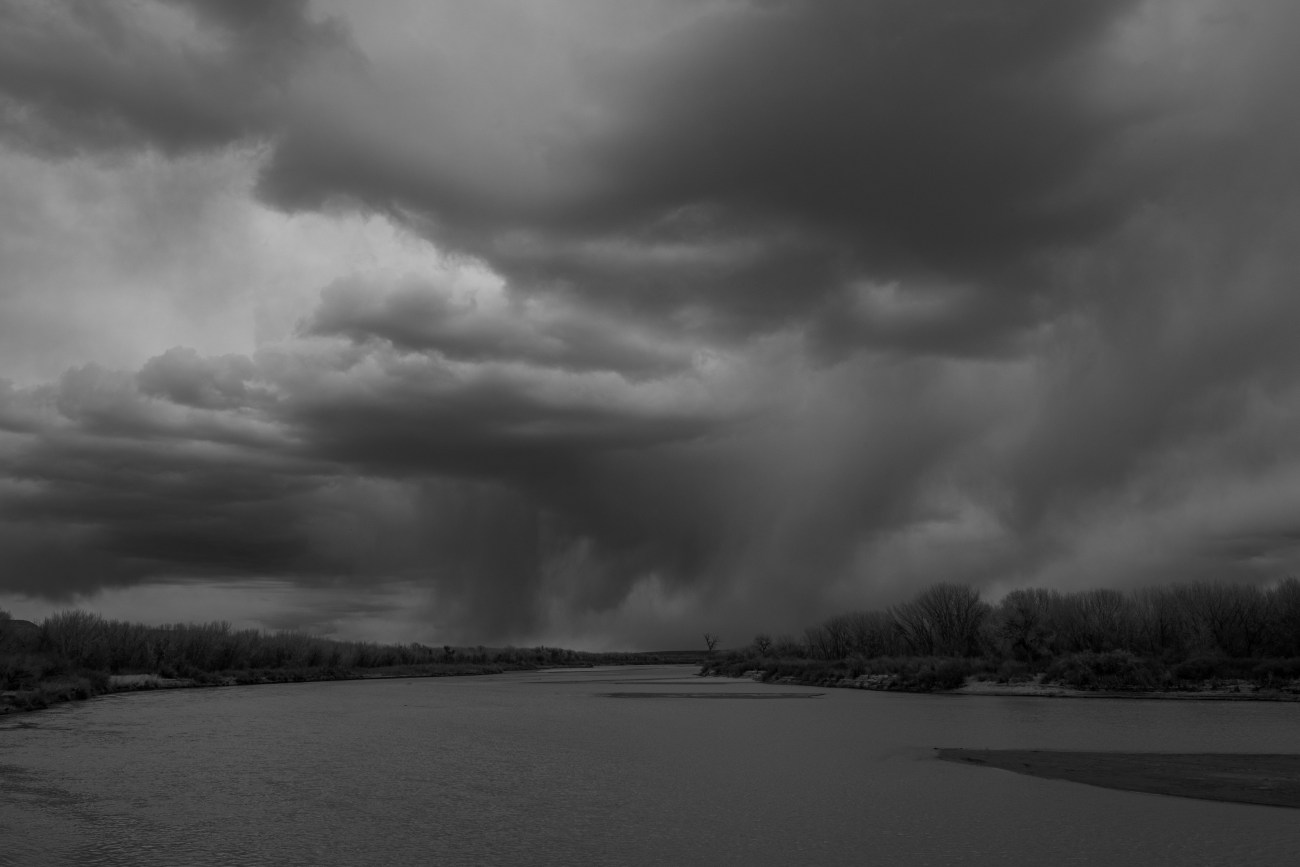
Spring storm clouds over the Green River in the Ouray National Wildlife Refuge March near Ouray, Utah on the Uintah & Ouray Reservation.
Russel Albert Daniels
The past two years have been especially brutal, as the winter runoff has dwindled and the worst drought in the West in at least 1200 years have pushed the Colorado river towards catastrophic ecological collapse. The plight of the razorback and the other endangered native Colorado River basin fish, says McKinnon, are “a concrete, real-world example of how climate change magnifies a whole slate of existing threats to endangered fish.”
The US Fish and Wildlife Service first listed the razorback as endangered in 1991, and the species would be extinct in the Upper Basin but for the hatchery program, which was established in 1996 as part of the Upper Colorado River Endangered Fish Recovery Program and is funded by the US Fish and Wildlife Service. The program has been successful enough that last year, FWS proposed downlisting the razorback from “endangered” to merely “threatened” under the Endangered Species Act. But the extreme mega-drought of the past two years makes that proposal seem wildly optimistic.
“We’ve had a series of dry years,” says Bart Miller, the healthy rivers director for Western Resource Advocates that is a partner in the recovery program. “There’s less water in the rivers, and that’s having an impact on fish,” he says. “Lower flows mean higher temperatures” that benefit invasive species, while the lower water levels can leave the fish stranded when their habitat gets fragmented into pools.
The level of water stored in Colorado basin reservoirs has plunged precipitously during the past 20 years, and even more dramatically in the past two. At 27 percent capacity, Lake Mead, behind Hoover Dam, is so low that human remains are resurfacing from the bottom. Lake Powell, created by the Glen Canyon Dam in 1963, has dropped 165 feet since its creation and is at 25 percent capacity. If it falls another 43 feet, the turbines in the dam will cease to function, and about 5 million people, including members of the Navajo Nation, will have to find another source of electricity.
To protect these reservoirs, the seven states that rely on the river to supply 40 million people with water are scrambling to find a way to voluntarily cut consumption by as much as 30 percent to head off the crisis. But this summer, water managers and state officials failed to come to any sort of agreement on how to make those cuts, and the US Bureau of Reclamation, which controls the dams, is now poised to impose what promise to be painful federal water mandates on the states. There are so many competing interests—agriculture, real estate development and golf courses, hydropower companies, Native American tribes who’ve been screwed out of water rights for a century—all claiming a share of the ever-shrinking river. Even the motorboat lobby, houseboat aficionados, and Jet Ski enthusiasts (collectively known as “Powellheadz”) have organized to demand that the Bureau refill Lake Powell to bring back marinas recently shuttered because of low water levels. Meanwhile, environmentalists are pushing to kill off “Lake Foul” for good by (metaphorically) blowing up the hated Glen Canyon Dam, as the writer Edward Abbey proposed in his memorable 1975 novel, The Monkey Wrench Gang.
Which brings me back to those ancient fish lazing about in the tanks and ponds of the Ouray hatchery. Because of their protected status, the chunky tuba-lipped fish are supposed to have some rights to the Colorado River water, too. “These fish exist nowhere else in the world,” says Matthew Breen, the native aquatics project leader for the Utah Division of Wildlife Resources’ Northeastern Regional Office. “That’s something worth preserving, right?”
But as with Lake Powell, their future does not look especially bright, despite the best efforts of the hatchery workers who were trying to coax some eggs out of a couple of tanks full of ripened razorback suckers.
The Ouray National Fish Hatchery is a small facility at the northern end of the Ouray National Wildlife Refuge in eastern Utah, a 16-mile stretch along the Green River designated as a sanctuary for migrating birds in 1960. The Green River is the Colorado’s largest tributary, and in the refuge, its muddy waters ripple through a lovely riparian space full of cottonwood galleries, mule deer, elk, migrating birds, endangered fish, and a species of endangered hookless cactus. It’s a critical habitat for the razorback, and in some ways, the fate of refuge seems nearly as precarious as that of the imperiled fish sheltered there. This modest Eden nested between the Uinta and Wasatch mountains is completely surrounded by the major oil and gas fields of Utah’s Uinta Basin, which local environmentalists have dubbed “Mordor” in reference to the industrial hellscape of J.R. Tolkien’s Lord of the Rings.
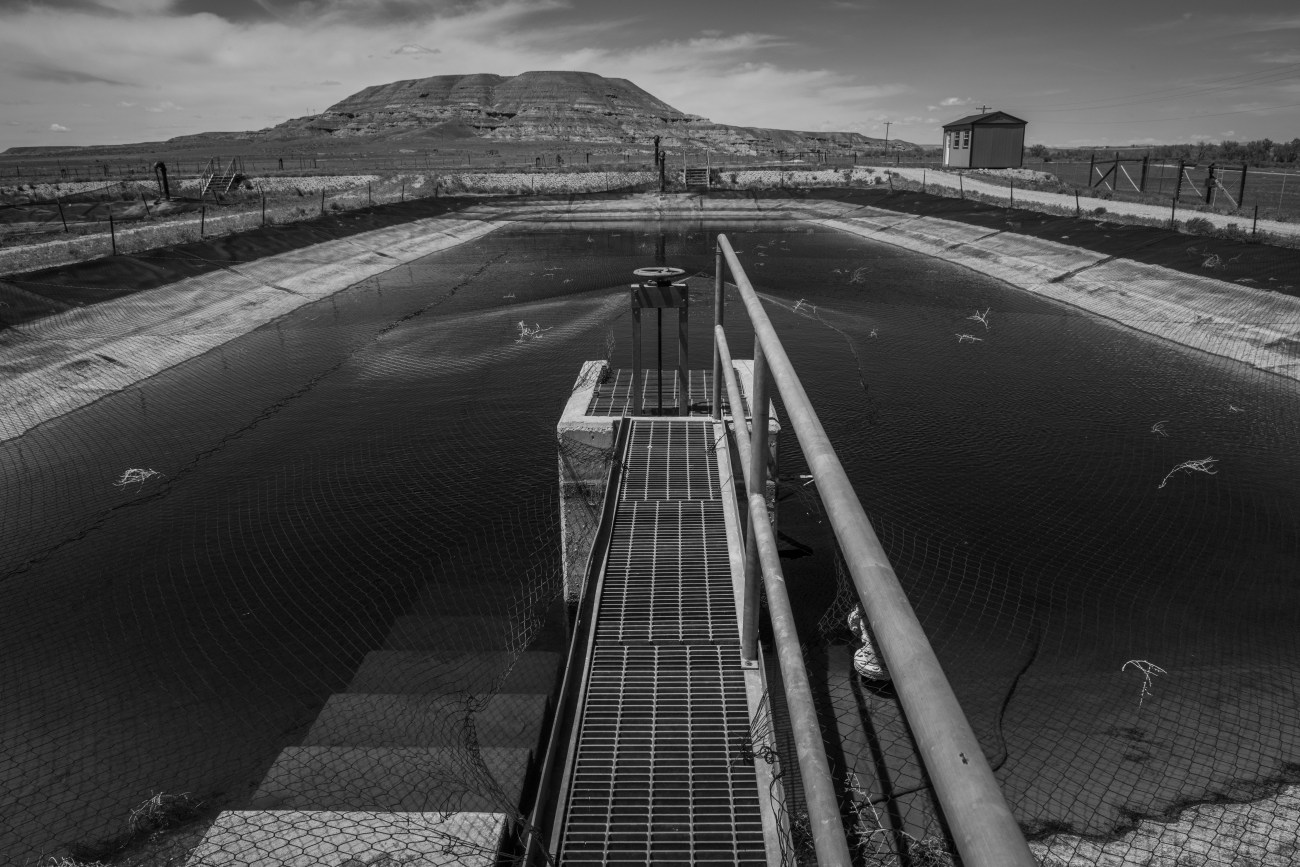
Holding pools for endangered fish at the Ouray National Fish Hatchery.
Russel Albert Daniels
Oil companies have been trying for years to tap the oil and gas reserves underneath the refuge, where surface rights are owned by the Fish and Wildlife Service but the mineral rights underground are still controlled by a collection of private interests and the state of Utah. In 2013, Thurston Energy applied to drill two test wells mere feet from the fish hatchery. Fish and Wildlife Service employees responded with alarm about the potential impact on the endangered fish through groundwater contamination and potential oil spills in the Green River, not to mention the health of the hatchery workers who’d be exposed to the emissions.
“As you can understand, a fish hatchery is only as good as its water source,” reads one 2013 report obtained by the Center for Biological Diversity through a public records request.
“Contamination of the water supply to Ouray NFH could cause a complete loss of the facility and require a complete relocation of the entire operation. The Recovery Program estimates that the replacement cost of the facility alone is $10 million… estimates do not include the high recovery value of the fish housed at the facility, the loss of genetic material, or the protracted length to achieve recovery if these recovery resources were lost. Because the Ouray NFH contains resources that are priceless, rare, require long-term work, and are critical to recovery, special risk management must be considered…Overall, it may be impossible to adequately protect the Ouray NFH under the current proposed action and location of the proposed oil wells.”
A year later, oil prices plunged and the proposal languished. But in 2019, the Trump administration approved Thurston’s proposal to drill two wells inside the refuge, though farther away from the hatchery. Last fall, the state of Utah issued final permits. “Most of the oil and gas wells are located away from the river floodplain,” a US Fish and Wildlife Service spokesperson explains via email. “While the potential for spills can pose a risk, they have been rare.”
The entrance to the refuge is on State Route 88, directly across from a couple of oil pumpjacks, which cloaked what should have been a pristine area with a faintly industrial stink. Happily, when I entered the fish hatchery, a nondescript, low-slung concrete building, it smelled more like fish than petroleum products. Olsen provided a quick tour—quick because most of the work took place in one large room full of fish tanks. Curling pictures of fish and yellowing newspaper clippings adorned bulletin boards in the lobby, which was the extent of the visitor center. The main room had a high warehouse ceiling criss-crossed with PVC and other water pipes and a network of metal grates along the floor for drainage. A sign over a walk-in fridge declared “fish food storage.”
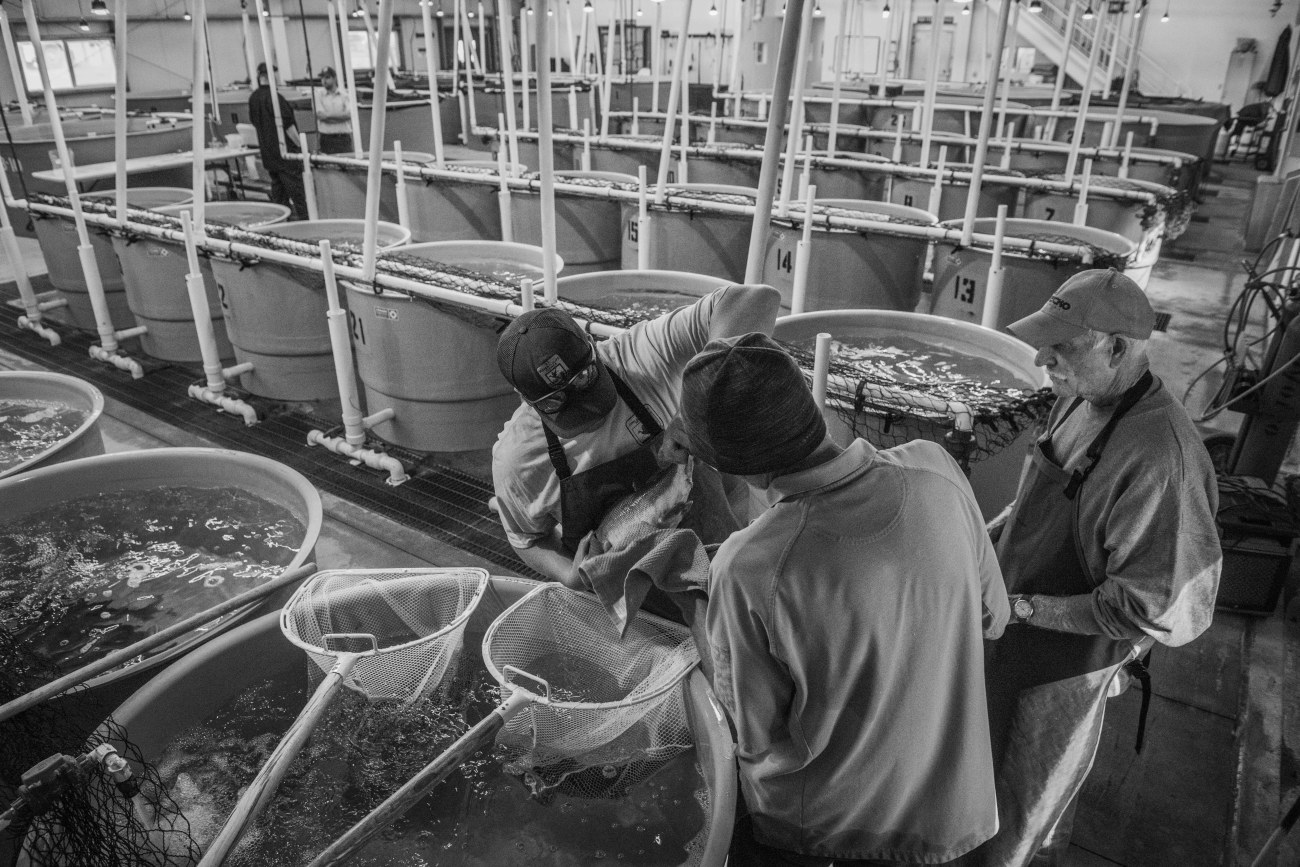
(Lt to rt) Zane Olsen, Trent Thompson, and Bruce Haines at the Ouray National Fish Hatchery near Ouray, Utah.
Russel Albert Daniels
With a modest budget of about $640,000 in 2022, according to the US Fish and Wildlife Service, the hatchery is surprisingly low-tech; only three full-time employees work there, so it relies on volunteers to help with the spawning. Today, with promises of burgers on the grill and fresh watermelon for lunch, Olsen has roped in the facility maintenance man Trenton Thompson; Bruce Haines, a retired former Fish and Wildlife Service staffer; and a couple of guys who’ve come down from the trout hatchery at Jones Hole to assist the permanent staff.
A handful of workers in wellies joked with each other over the low roar of water pumps churning a dozen or so fish tanks that looked like smaller versions of above-ground swimming pools. But they took the work seriously. When photographer Russel Daniels, who’d come with me, inquired whether Olsen had ever eaten one of the fish, he and his colleagues recoiled with genuine horror. “That’s a $10,000 plate,” an unsmiling Olsen informed him, citing the steep fines and possible jail time for harming the rare fish.
After my tour, I don a big yellow rubber apron and join the huddle around one of the big fish tanks for a tutorial on fish spawning. Thompson’s facility maintenance title vastly understates the scope of his duties. I watch as he expertly extracts a female fish, which is about two feet long, from a water tank and holds it for Olsen, who explains that the fish are equipped with PIT tags—short for Passive Integrated Transponder—that track them after they are released into the wild and help ensure that the spawning involves the right genetic mix. (No ichthyological intermarriage here!) He waves a wand over the fish to log the data from PIT tag before drying the fish off with a towel he throws over his shoulder like a chef. It’s important to keep the ladies dry, he explains, because razorback sperm, which they’ll mix with the harvested eggs, is activated by water, and will live for only 60 seconds once it gets wet.
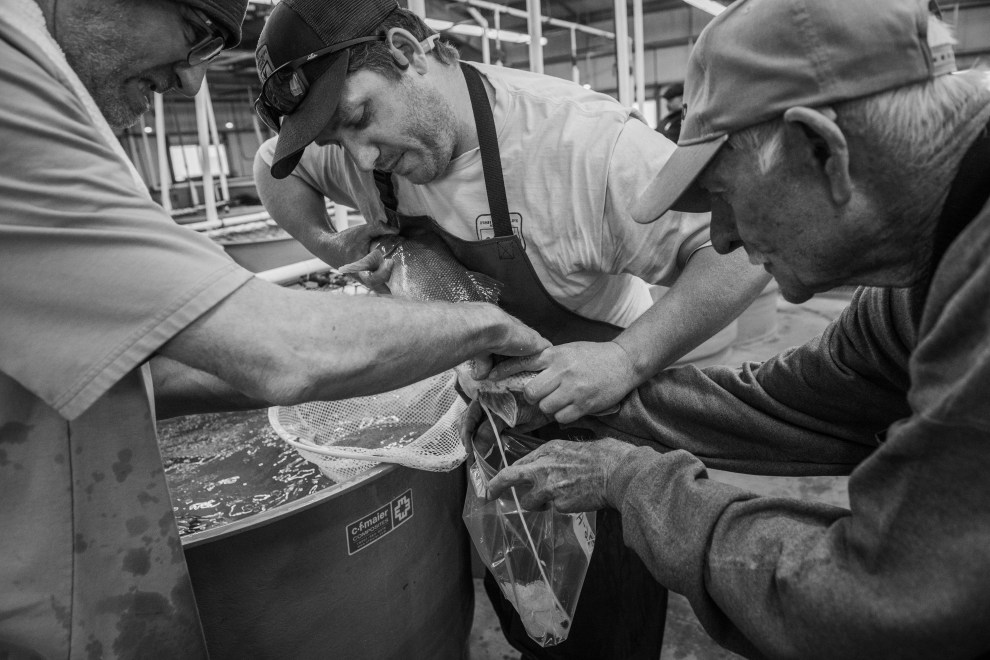
(Lt to rt) Zane Olsen, Trent Thompson, and Bruce Haines express eggs and milt from a razorback sucker for incubation.
Russel Albert Daniels
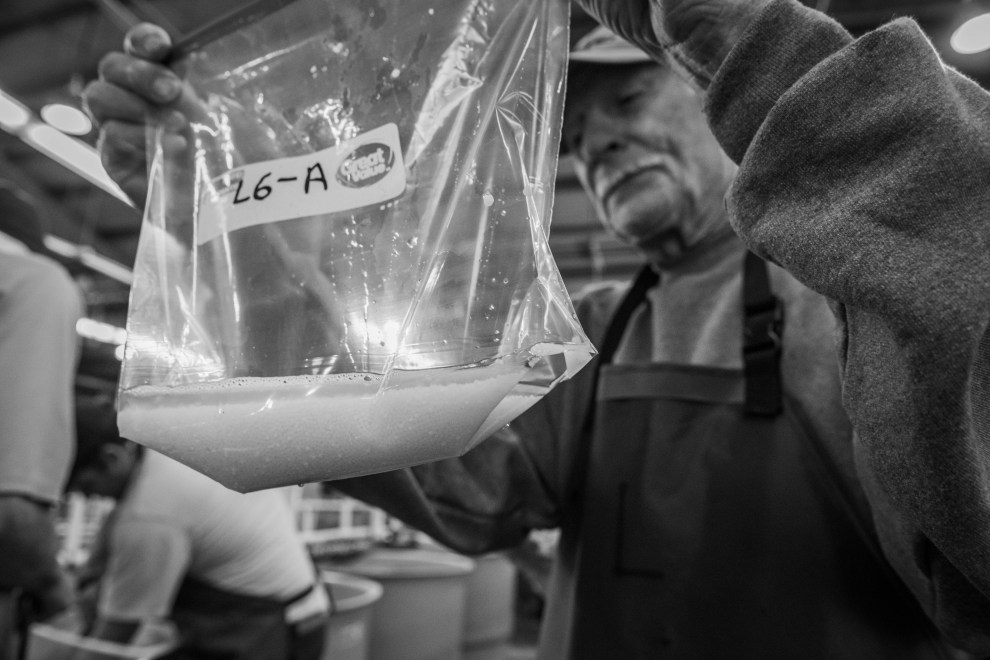
Bruce Haines with express eggs and milt from a razorback sucker.
Russel Albert Daniels
Thompson cradles the big fish as Olsen gently massages its soft white belly and sends a stream of eggs squirting out into a plastic Ziploc bag Haines holds awkwardly under its tail. The process is not unlike milking a cow. Thompson plops the fish back into another tank and pulls out another victim and I get to take over the belly rubs.
Olsen asks if I want to hold one of the aquatic dinosaurs myself. Of course, I do! Spawning endangered razorbacks might be one of the coolest things I’ve ever done. But the stakes seem high. I imagine the headline: “Reporter drops, kills rare fish.” Luckily, when I reach into the tank and pull her out by the tail, the razorback flops only a little. I carefully cover her eyes to calm her while Thompson rubs his hand along her underside. I try to explain to her that the misery will be short and that it’s for a good cause. She has some heft to her and seems like a hearty soul for a rare fish. She doesn’t protest, soon gives up her eggs, and I return my charge to her little pool.
After adding sperm to the bag and giving the mix a tannic acid wash to prevent clumping and fungus growth, workers take the fertilized eggs to a special isolation room designed to keep out parasites and bacteria and transfer them to special jars for incubation. With luck, nine days later, at least 10,000 fry will appear. In the wild, they would feed on zooplankton but here will subsist on brine shrimp from the Great Salt Lake for about two years, graduating from the tanks to half-acre long rubber-lined ponds.
Holding a million gallons of filtered water, the ponds are covered with ropes and netting to help keep out the cormorants, osprey, and other shorebirds that view the fish-rich ponds as an “all-you-can-eat chuck-a-rama,” says Thompson, who occasionally has to deploy a rifle loaded with M-80 fireworks to scare off the predators. After about two years, once the fish reach 24 inches long, they’re released into the wild. About 80 percent will make it to the river, Olsen says.
What he doesn’t say is that the fish struggle once they’ve been released, and few of them will reach their natural lifespan of 40 or 50 years. Breen says the last native population of elder fish started to disappear in the early 2000s. In the past few years, however, wildlife experts have started to see some adult razorbacks in the river that had been released from captivity in 2014 and 2015, a hopeful sign. And recently, according to the US Fish and Wildlife Service, they’ve seen the “first confirmed wild-recruited razorback sucker in the Upper Basin since the 1990s.”
“Without the hatchery,” Breen says, “none of it would have been possible.
The Ouray hatchery is just one part of the Upper Colorado Endangered Fish Recovery Program, a collaborative effort created in 1988 by water users, electric companies, state and federal agencies, Native American tribes, and conservation groups to try to recover the four endangered fish species that once were plentiful in the Colorado River. Essentially the very same entities that had endangered the fish in the first place came together to try to save them. This wasn’t solely an exercise in benevolent conservation. The program was specifically created to head off lawsuits under the Endangered Species Act, which required states to consider things like fish habitat when green-lighting projects that would drain more water from the river basin. Nonetheless, the cooperative program is a sea change from decades past when many of these same agencies were actively trying to kill off some of the native fish in the interest of economic development.
Some of the same agencies now involved in the endangered fish recovery program are partly responsible for hastening their demise. In 1962, the US Bureau of Reclamation completed the construction of the Flaming Gorge dam on the Green River, about 75 miles north of the Ouray refuge. Promoters had promised the dam would provide immense economic benefits to the region, not just by providing water for irrigation and development, but by creating a massive reservoir stocked with non-native trout to attract visitors who liked sport fishing.
Even then, western water managers knew that such artificial lakes would fill up quickly with trash fish like carp that not only devoured all the native fish but also the prized rainbow trout. So state agencies in Utah and Wyoming decided to give the farm-raised trout a head start by spreading the poison rotenone over nearly 445 miles of the Green River before the dam was closed. In just three days, 450 tons of fish were killed. Dead fish were found as far away as Dinosaur National Monument, where state officials had promised the fish would not be affected. The episode was such a scandal that then-Interior Secretary Stewart Udall sent a letter to the chairman of the American Society of Ichthyologists and Herpetologists apologizing for the disaster; he promised nothing like that would happen again.
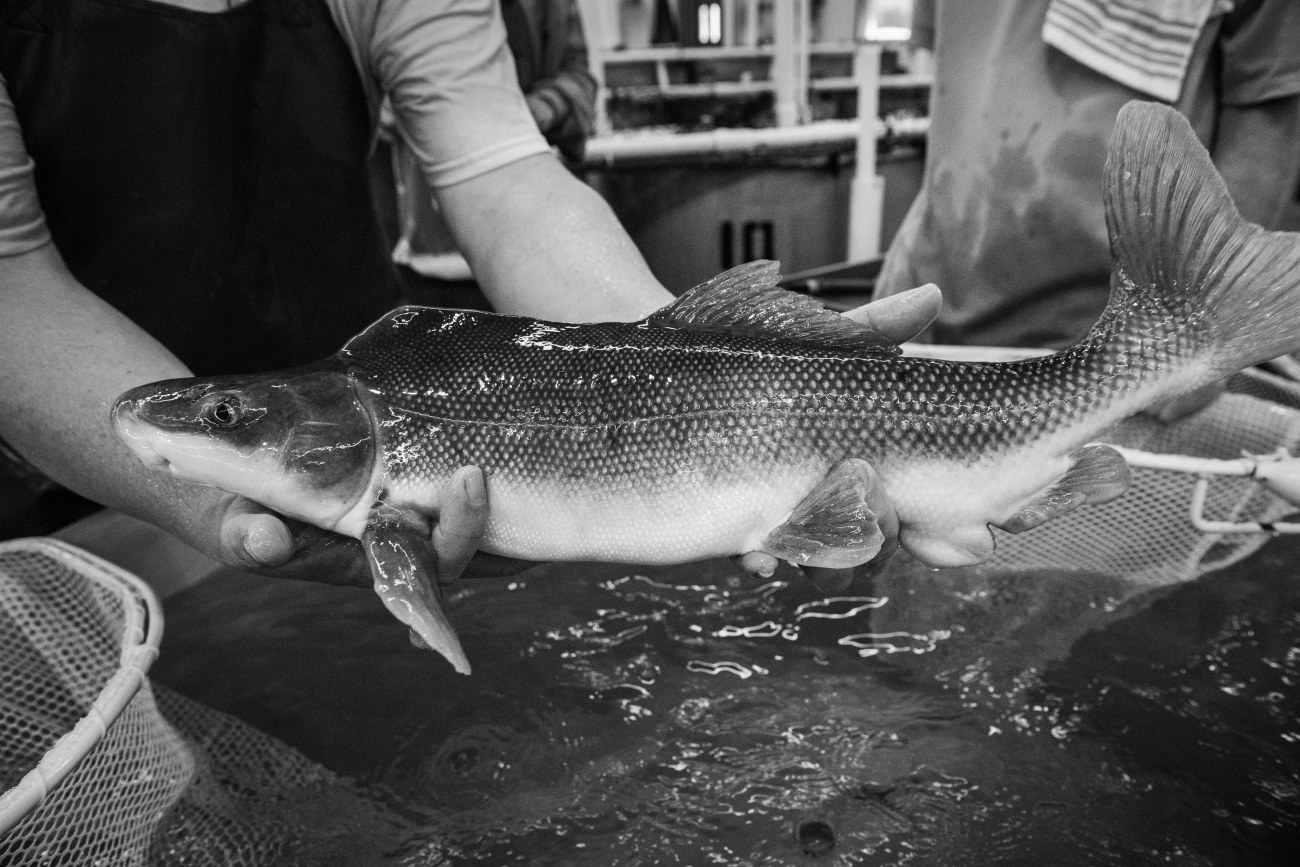
A razorback sucker is an endangered, native fish of the Colorado River watershed, which it has inhabited for over 3 million years. They are found nowhere else on earth.
Russel Albert Daniels
And yet, what fish the poison didn’t kill, the dam did. The water released from Flaming Gorge was too cold for the razorback to thrive, and the change in water flow destroyed the natural side channels and wetlands of the Green River, where the native fish historically spawn and hide out from predators until they’re old enough to survive in the deep river water. Thanks to the recovery program, the Bureau of Reclamation has tried to time water releases from Flaming Gorge to mimic the natural flows of the river to give the razorback larvae a fighting chance. And more recently, scientists have been working with the bureau to create new wetlands on the Green specifically for fish habitat, which has proven moderately successful.
Still, new threats to the fish from the climate-change-driven drought are significant—though not always obvious. Historically, most of the funding for the fish recovery program has come from the sale of hydropower at the very dams that endanger the fish in the first place. But thanks to the drought and low water levels, the hydropower system on the river has been producing about 40 percent less electricity this year. As a result, the US Bureau of Reclamation has had to cover the fish recovery program’s deficit.
Meanwhile, demand for water continues to grow in the West, along with the population in states like Utah that are dependent on the Colorado River. Utah—which uses more water per capita than any southwestern state and has the lowest water rates—has refused to impose measures adopted in other basin states to cut down on wasteful water use, such as mandating the use of water-efficient plumbing fixtures in new construction or raising water rates to encourage conservation. Much of the water used in Utah isn’t even metered, a basic requirement for figuring out how much is getting used by whom and how much can be cut.
To keep those Glen Canyon turbines spinning, Lake Powell needs more water. But without big cuts in consumption, the obvious solution for filling the reservoir is stealing the water from somewhere else in the system. Flaming Gorge reservoir on the Green River, which also happens to be the habitat for the razorback suckers raised at the hatchery, is one of the few reservoirs in the basin that is anywhere near capacity, and thus a ripe target for state agencies looking to avoid other, painful cuts to water consumption.
The Bureau of Reclamation announced earlier this year that it would release 500,000 acre-feet of water from Flaming Gorge to try to stabilize the reservoirs downstream. In the short term, Breen says, those releases should be good for the endangered fish, as they’re timed to benefit the razorback sucker’s reproductive cycle. But it is ultimately robbing Peter to pay Paul. The Green River water flows have already fallen 20 percent since 2000, and the Colorado River Basin has been oversubscribed for decades, with states claiming rights to more water than remains in the river. Its major reservoirs have been drained as the winter snowpack has diminished. It was a record 107 degrees in Salt Lake City this week.
“The system is approaching a tipping point, and without action we cannot protect the system and the millions of Americans who rely on this critical resource,” M. Camille Calimlim Touton, commissioner of the Bureau of Reclamation, said during a news conference in August. “Protecting the system means protecting the people of the American West.”
Meanwhile, the biggest ongoing threat to the Colorado’s endangered fish is other, nonnative fish. Only 12 fish are native to the Upper Colorado River Basin, Breen says. But now more than 50 species compete in the rivers. Many that were intentionally introduced to promote sport fishing are highly predatory in a way the razorback and others have not evolved to survive.
“Warmer, low flows also benefit invasive fish species like smallmouth bass, exacerbating the problems posed by that species,” a Fish and Wildlife Service spokesperson told me in an email. “These nonnative smallmouth bass spawn and hatch in summer, as do the Colorado pikeminnow, and grow at a much faster rate than native fishes.”
The recovery program spends more than $2 million a year trying to eliminate the non-native fish from the Green River and elsewhere in the system—a move that is not always popular with local anglers who like to fish for the bass. “For the record: I love smallmouth bass,” says Breen. “I grew up fishing for smallmouth bass in the Midwest. But that’s where they’re supposed to be. Bass are very predacious, and they’re not supposed to be in that river.”
The smallmouth bass invasion had been somewhat contained to the upper Colorado watershed, but this summer, as the river has dried up, the reservoir in Lake Powell is allowing warm water to flow through the Glen Canyon dam, and with it, the smallmouth bass. Much to the dismay of conservationists and wildlife managers, the bass are now starting to make a foothold in Grand Canyon, the last pristine habitat for the humpback chub, another native Colorado River fish whose status had been downgraded by the Fish and Wildlife Service from endangered to threatened. The arrival of the bass threatens to undo all that progress.
That’s one reason why McKinnon is skeptical that the fish like the razorback raised in a hatchery are sufficiently recovered enough to come off the endangered species list. “The program has proven to be an excellent exercise in feeding non-native bass,” he says, “but not creating the self-sustaining populations that recovery requires.” He says a massive public investment has been made in the hatchery program, but “those fish still aren’t able to successfully reproduce in the wild. They’re able to spawn, but the juvenile fish are consumed by nonnative fish.”
In March, Breen co-authored a paper in Fisheries, a journal of the American Fisheries Society, arguing that what the Colorado’s endangered fish really need to thrive is simply more water in the river, with natural flows unimpeded by dams and other artificial obstructions. “Unless we prioritize conservation of riverine ecosystems, native species populations will likely continue to decline as flows are further reduced by climate change and human water use,” the authors conclude.
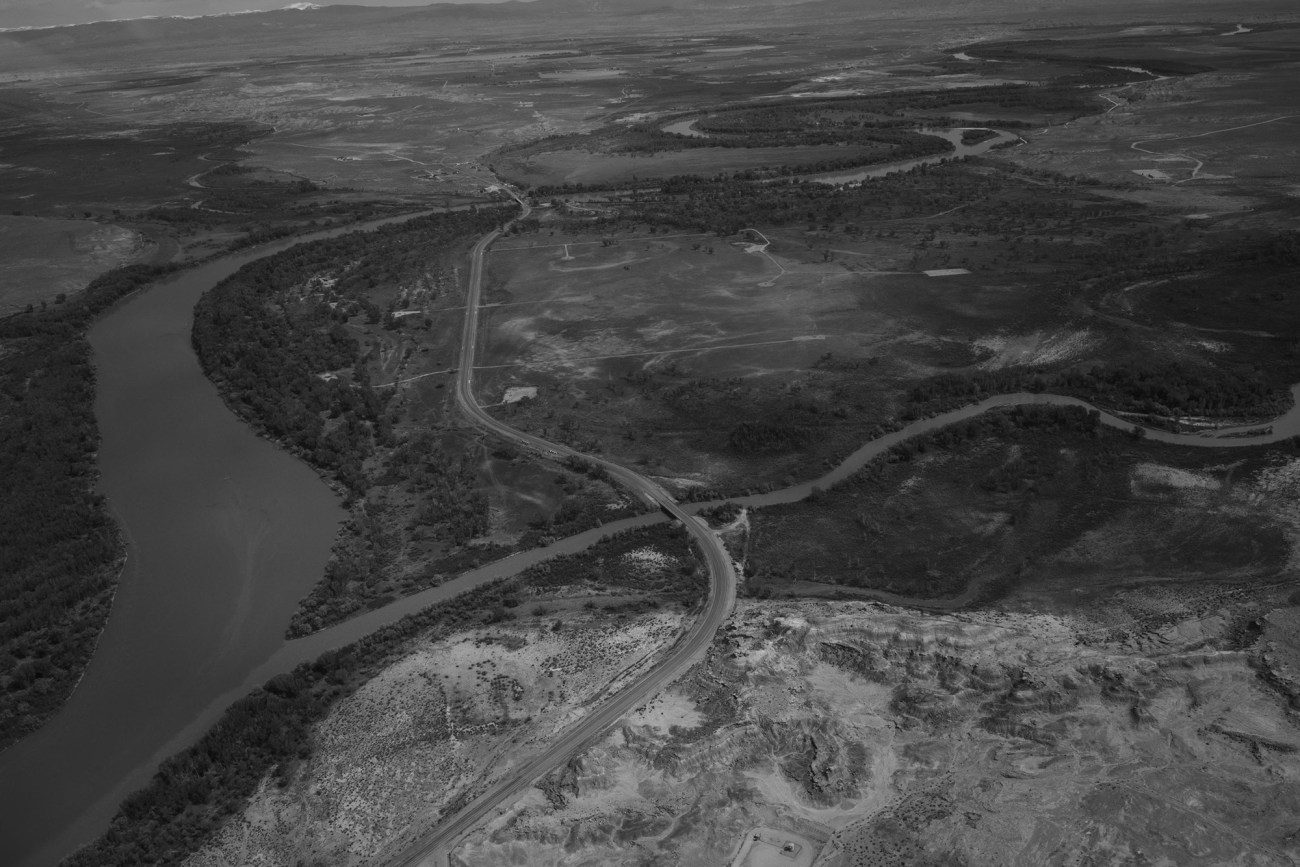
The White River near the confluence with the Green River.
Russel Albert Daniels
More water is the obvious solution but also improbable. Real estate developers committed to lawns and golf courses, alfalfa farmers, and big California cities are unlikely to be willing to sacrifice water to save some big, ugly fish no one wants to eat. Only one major tributary still has the natural water flow required to sustain the endangered native fish, and that’s the White River, which meets the Green not far from the Ouray hatchery. But water companies long have had their eyes on the White for a dam to fuel more development in Colorado.
Until and unless there’s more water in the Colorado River basin, the future of the razorback sucker will depend a lot on the Ouray hatchery. At the end of my visit, I snapped a photo of Olsen holding up a life-sized model of the Colorado pikeminnow, which grows up to six feet. He gives me some endangered fish trading cards, courtesy of the recovery program. We talk about how this messy, wet job he does is almost all that stands between an ancient fish and extinction. I suggest he’s doing the lord’s work among the water dinosaurs. Olsen gives me a crooked smile, “It is pretty cool, isn’t it?”
This article was supported by The Water Desk, an independent journalism initiative based at the University of Colorado Boulder’s Center for Environmental Journalism. Aerial support provided by LightHawk.
